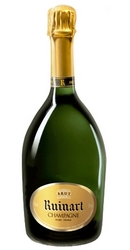For lovers of Ruinart Champagne, price is not that important a factor. Champagne is not cheap, of course, and especially so for quality Champagne. There are cheaper sparkling wines out there, for sure. You’ll get a decent Cava, Prosecco or Franciacorta for a fraction of the price or Ruinart or any other top Champagne. But when people buy Ruinart, they are buying Ruinart. It is an established, luxury Champagne label, and its price reflects that.
For those of you that may not be entirely convinced when it comes to Ruinart and other iconic Champagnes, the question becomes: Is the Ruinart Champagne price fair? Does Ruinart Champagne offer value for money, despite its relatively high price?
Let’s take a look.
How does the Ruinart Champagne price compare with other labels?
Ruinart Champagne is a luxury brand, and its positioning within the Champagne category is pretty high-end. The Ruinart identity is different to that of, for example, Moët & Chandon, despite the fact that both houses are owned by the same parent company. Where Moët & Chandon and its special cuvée Dom Pérignon are unashamed symbols of luxury, Ruinart is more discreet and subtle.
It’s a unique brand. Ruinart has a small, loyal following of discerning wine lovers. It’s not a flashy Champagne, less at home in nightclubs and more in restaurants. As a result, it’s hard to compare Ruinart Champagne prices with most other Champagne brands on a like-for-like basis.
Many non-vintage Brut Champagnes are more or less interchangeable. When it comes to Champagne as a gift or for a toast, most bottles will do the trick – Mumm Cordon Rouge, Veuve Clicquot Yellow Label or Möet & Chandon Imperial. Of course, each wine is different, but they can all serve a similar purpose. Quality Champagnes, reliable and consistent styles and instantly recognisable brand names. Unsurprisingly, most of these houses’ non-vintage wines are quite similar in price.
Ruinart’s non-vintage Champagne is a little more expensive. Why?
Why Ruinart Champagne’s prices are higher
For a start, there’s less of it made. Total production at Ruinart is around 2.5 million bottles per year, across all its cuvées. That’s dwarfed by other labels like Mumm (5 million bottles), Veuve Clicquot (10 million bottles) and Moët & Chandon (26 million bottles).
Smaller production can mean higher production costs, thanks to fewer economies of scale, and scarcity, which pushes up demand. Both push up prices, sooner or later. As part of the LVMH group, economies of scale and production costs are hardly a paramount concern. With Ruinart, the bigger issue is surely scarcity.
Supply of Ruinart Champagne is lower than many other brands from the get-go, and distribution is strictly controlled. You may notice that you don’t often see bottles of Ruinart in nightclubs or at the supermarket. You certainly won’t see the sort of big marketing campaigns typical of some “louder” Champagnes.
This is more of a specialist’s sparkling wine, for connoisseurs and future connoisseurs – that the average Ruinart Champagne price may be a little higher than some competitors is not a big problem, so much as what’s in the bottle itself. In that regard, its price is more than fair: Ruinart Champagne is not cheap, but its quality ensures that it’s always good value.
If you’re curious to know what’s in the bottle, read on. Let’s finish up with a quick tasting of Ruinart’s non-vintage Brut.
Tasting Ruinart R de Ruinart Brut
 For most Champagne houses, the non-vintage Brut is their flagship wine. Perhaps unsurprisingly, Ruinart does things a little differently. Ruinart is best known for its 100% Chardonnay, Ruinart Blanc de Blancs. In the interest of comparison and contrast, however, we’re looking at Ruinart R de Ruinart, the non-vintage Brut.
For most Champagne houses, the non-vintage Brut is their flagship wine. Perhaps unsurprisingly, Ruinart does things a little differently. Ruinart is best known for its 100% Chardonnay, Ruinart Blanc de Blancs. In the interest of comparison and contrast, however, we’re looking at Ruinart R de Ruinart, the non-vintage Brut.
-
Sight:
Its colour is a deep gold, and its mousse is intense and long-lasting.
-
Smell:
There’s an explosion of aromas here. First, it’s fruit. Citrus fruits like lemon and lime are joined by white apple and pear. Stick with it and you’ll pick up some pastry and yeast aromas, finishing with a floral note. This is seriously complex for what is effectively the house’s entry-level wine.
-
Taste:
There is surprising body here, particularly when compared to some of the more famous non-vintage Champagnes out there. This is kept in balance with tingling acidity, however, making for a very harmonious palate indeed. The finish is long and memorable.
Alcohol content: 12%Serve between 4ºC and 8ºCOptimal consumption period: 2017-2018Best served in Champagne GlassPairing: Appetizers, Bluefish, Fowl, Seafood, Soft Cheese, Whitefish.
Buy Ruinart R de Ruinart here.
[cta_generico id=2597]


